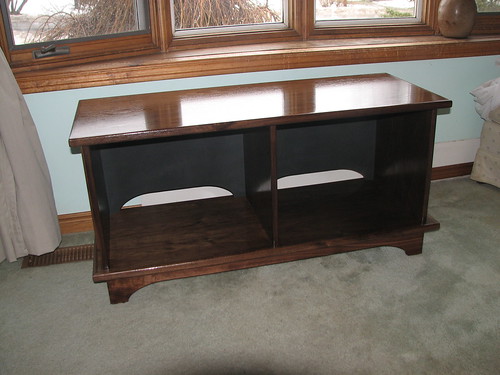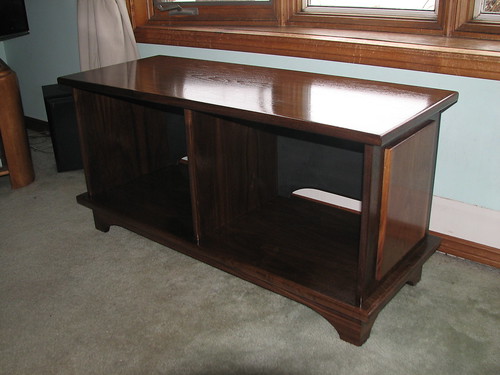Well it’s been a long time coming, but the long-awaited TV stand is finally a reality… much as it pains me to use “reality” and “TV” in the same sentence.
It’s posing here under the living-room window to show off its shiny finish, but obviously this is not its final home. It needs to go into the corner, but not until I dismantle all the existing devices and make room for it… which I’m avoiding doing even as I type this.
The piece is made from walnut-veneered material, with solid walnut base, trim, and accents. It’s a pretty straightforward case design, employing biscuit joinery for the flat pieces, and just glue for the edge trim. The base is attached with pocket screws. During the design process, I decided that providing a shelf was not going to be necessary, based on our components that are going in here, it will be better to just stack them. If I change my mind again, it should be simple enough to add a shelf.
The piece had some walnut stain applied… long story… I noticed too late that there was some funky stuff going on with one of the side pieces, where the veneer was allowing the underlying particle board to show through. I attempted to fix this with stain, but this was not successful at hiding the problem. So what I came up with was to apply a flat panel of solid walnut to each side, left unstained to let it stand out as an accent piece. Looks okay, I think. I’m still worried that wood movement may cause the accent panels to become unstuck from the sides, but I’ll deal with that when and if…
I made the base with a pretty standard arched cutout to form “feet” at the corners. The base pieces are solid walnut, mitered at the corners, with the arch feature on all four pieces. When considering the back of the case, which is just 1/4″ hardboard painted black, I wanted to leave holes for ventilation at the top, and wires at the bottom. Rather than just drill the usual holes for this, I elected to repeat the arch detail of the base. I made four cutouts, two top and two bottom, to allow for feeding wires to both sides, and for air movement. You can only see the bottom ones in the photos.
 Finally, I should talk about the edge trim. It’s solid walnut, just with simple 1/4″ roundovers on the three vertical pieces, but for the top and bottom I wanted something a bit more substantial. By using a full one-inch piece, I was able to “wrap” it around the edge, providing way more glue surface, as well as support from underneath, making it safer to grab and lift the finished piece without the trim ripping off. And of course it gives the illusion that the top and bottom are themselves a full inch thick.
Finally, I should talk about the edge trim. It’s solid walnut, just with simple 1/4″ roundovers on the three vertical pieces, but for the top and bottom I wanted something a bit more substantial. By using a full one-inch piece, I was able to “wrap” it around the edge, providing way more glue surface, as well as support from underneath, making it safer to grab and lift the finished piece without the trim ripping off. And of course it gives the illusion that the top and bottom are themselves a full inch thick.
I’m just glad it’s done…


